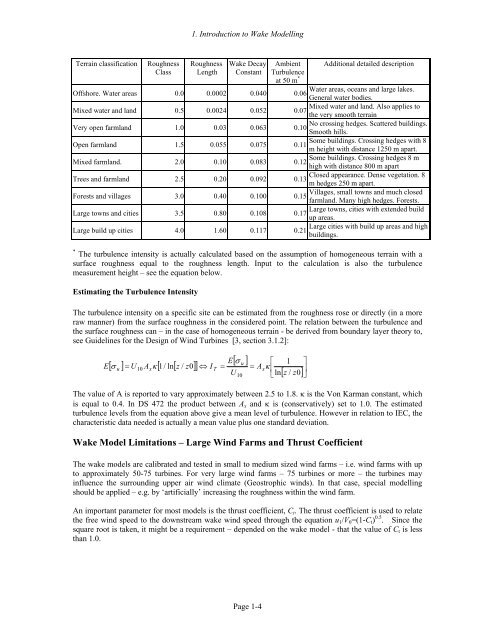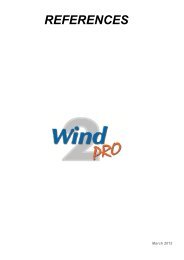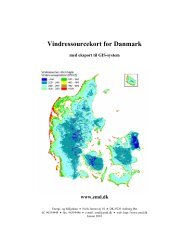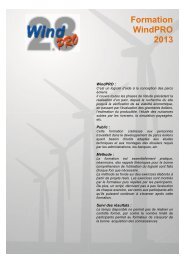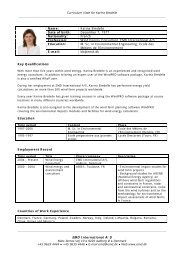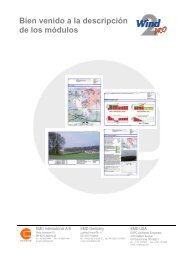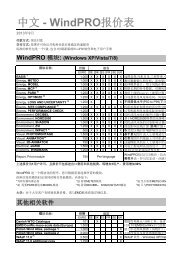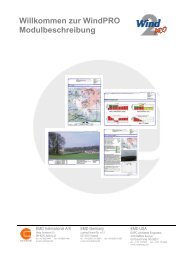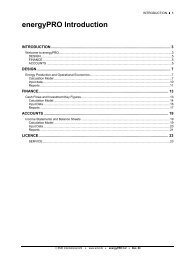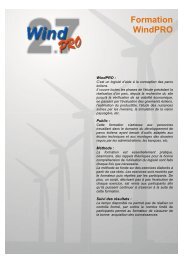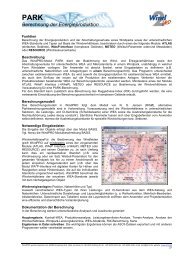WindPRO / PARK - EMD International AS.
WindPRO / PARK - EMD International AS.
WindPRO / PARK - EMD International AS.
Create successful ePaper yourself
Turn your PDF publications into a flip-book with our unique Google optimized e-Paper software.
1. Introduction to Wake Modelling<br />
Terrain classification<br />
Roughness<br />
Class<br />
Roughness<br />
Length<br />
Wake Decay<br />
Constant<br />
Ambient<br />
Turbulence<br />
at 50 m *<br />
Additional detailed description<br />
Offshore. Water areas 0.0 0.0002 0.040<br />
Water areas, oceans and large lakes.<br />
0.06<br />
General water bodies.<br />
Mixed water and land 0.5 0.0024 0.052<br />
Mixed water and land. Also applies to<br />
0.07<br />
the very smooth terrain<br />
Very open farmland 1.0 0.03 0.063<br />
No crossing hedges. Scattered buildings.<br />
0.10<br />
Smooth hills.<br />
Open farmland 1.5 0.055 0.075<br />
Some buildings. Crossing hedges with 8<br />
0.11<br />
m height with distance 1250 m apart.<br />
Mixed farmland. 2.0 0.10 0.083<br />
Some buildings. Crossing hedges 8 m<br />
0.12<br />
high with distance 800 m apart<br />
Trees and farmland 2.5 0.20 0.092<br />
Closed appearance. Dense vegetation. 8<br />
0.13<br />
m hedges 250 m apart.<br />
Forests and villages 3.0 0.40 0.100<br />
Villages, small towns and much closed<br />
0.15<br />
farmland. Many high hedges. Forests.<br />
Large towns and cities 3.5 0.80 0.108<br />
Large towns, cities with extended build<br />
0.17<br />
up areas.<br />
Large build up cities 4.0 1.60 0.117<br />
Large cities with build up areas and high<br />
0.21<br />
buildings.<br />
* The turbulence intensity is actually calculated based on the assumption of homogeneous terrain with a<br />
surface roughness equal to the roughness length. Input to the calculation is also the turbulence<br />
measurement height – see the equation below.<br />
Estimating the Turbulence Intensity<br />
The turbulence intensity on a specific site can be estimated from the roughness rose or directly (in a more<br />
raw manner) from the surface roughness in the considered point. The relation between the turbulence and<br />
the surface roughness can – in the case of homogeneous terrain - be derived from boundary layer theory to,<br />
see Guidelines for the Design of Wind Turbines [3, section 3.1.2]:<br />
E<br />
[ σ ] = U A κ[ 1/ ln[ z / z0<br />
]<br />
u<br />
10<br />
x<br />
⇔ I<br />
T<br />
E<br />
=<br />
U<br />
[ σ ]<br />
u<br />
10<br />
⎡<br />
= Axκ<br />
⎢<br />
⎣ln<br />
1<br />
⎤<br />
[ z / z0] ⎥ ⎦<br />
The value of A is reported to vary approximately between 2.5 to 1.8. κ is the Von Karman constant, which<br />
is equal to 0.4. In DS 472 the product between A x and κ is (conservatively) set to 1.0. The estimated<br />
turbulence levels from the equation above give a mean level of turbulence. However in relation to IEC, the<br />
characteristic data needed is actually a mean value plus one standard deviation.<br />
Wake Model Limitations – Large Wind Farms and Thrust Coefficient<br />
The wake models are calibrated and tested in small to medium sized wind farms – i.e. wind farms with up<br />
to approximately 50-75 turbines. For very large wind farms – 75 turbines or more – the turbines may<br />
influence the surrounding upper air wind climate (Geostrophic winds). In that case, special modelling<br />
should be applied – e.g. by ‘artificially’ increasing the roughness within the wind farm.<br />
An important parameter for most models is the thrust coefficient, C t . The thrust coefficient is used to relate<br />
the free wind speed to the downstream wake wind speed through the equation u 1 /V 0 =(1-C t ) 0.5 . Since the<br />
square root is taken, it might be a requirement – depended on the wake model - that the value of C t is less<br />
than 1.0.<br />
Page 1-4


